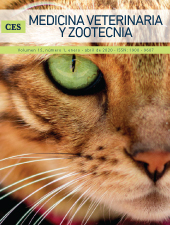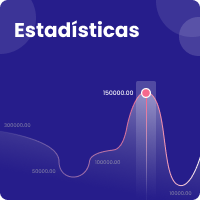Toxicidad de zinc por exposición subletal en trucha arco iris (Oncorhynchus mykiss)
DOI:
https://doi.org/10.21615/cesmvz.15.1.1Palabras clave:
Trucha arcoiris, metales pesados, Zinc, crecimientoResumen
TZinc (Zn), puede alterar diferentes procesos fisiológicos en peces, tales como, el crecimiento y los parámetros séricos. El objetivo de este estudio fue investigar la toxicidad de Zn en la exposición subletal de la trucha arco iris (Oncorhnychus mykiss). Los peces expuestos a niveles más altos de Zn crecieron más lentamente que los peces expuestos a niveles más bajos de Zn. El aumento de peso y la SGR (tasa de crecimiento específica) disminuyeron linealmente a medida que aumentó el nivel de Zn en el agua. El CF (factor de condición) de los peces cultivados en agua con una alta concentración de Zn, también disminuyó significativamente en comparación con la baja concentración de Zn, mientras que el índice de conversión de alimentos (FCR) aumentó con la concentración de Zn en el agua. Las actividades AST (Aspartate Transaminase) y ALT (Alanine Transaminase) fueron significativamente alteradas por el Zn y mostraron un patrón lineal y disminuyeron después de 30 días, mientras que los niveles de ALP (Fosfatasa Alcalina) mostraron un aumento notable desde un nivel medio de control. Este estudio sugiere que los parámetros bioquímicos de crecimiento y suero podrían usarse como biomarcadores importantes y sensibles para controlar la toxicidad de metales pesados en el estado de salud de los peces.
Descargas
Referencias bibliográficas
Adhikari S, Sarkar B, Chatterjee A, Mahapatra CT, Ayyappan S. (2004). Effects of cypermethrin and carbofuran haematological parameters and prediction of their recovery in a freshwater teleost. Labeorohita (Hamilton). Ecotoxicol Environ Saf 58: 220–226.
Alabater JS, Loyd R. (1980). Water Quality Criteria for Freshwater Fish. Butterworths. London. p 297.
Basaglia F. (2000). Isozyme distribution of ten enzymes and their loci in South American lung fish. Lepidosiren paradoxa (Osteichtyes. Dipnoi). Comp Biochem Physiol B126: 503–510.
Bedii C, Kenan E. (2005). The effects of Cadmium on levels of glucose in serum and glycogen reserves in the liver and muscle tissues of Cyprinus carpio (L).Turk J Vet AnimSci 29: 113-117.
Bernet D, Schmidt H, Wahli T. Burkhardt-Holm P. (2001). Effluent from a sewage treatment works causes changes in serum chemistry of brown trout (Salmo truttaL.). Ecotoxicol Environ Saf 48: 140–147.
Canli M. (1995). Effect of mercury. chromium. and nickel on some blood parame-ters in the carp. Cyprinus carpio. Turk J Zool 19: 305–311.
Chowdhury MJ, Pane EF, Wood CM. (2004). Physiological effects of dietary cadmium acclimation and waterborne cadmium challenge in rainbow trout: respiratory. iono regulatory. and stress parameters. Comp Biochem Physiol C 139: 163-173.
Detholff GM, Schlenk D, Hamm JT, Bailey HC. (1999). Alterations in physiological parameters of rainbow trout (Oncorhynchus mykiss) with exposure to copper and copper/zinc mixtures. Ecotoxicol Environ Saf 42: 253–264.
Do Carmoe Sa MV, Pezzato LE, Barros MM, Padilla PM. (2007). Optimum zinc su-pplementation level in Nile tilapia Oreochromis niloticus juvenile’s diets. Aquacul 238: 385-401.
Folmar LC. (1993). Effects of chemical contaminants on blood chemistry of te-leost fish: A bibliography and synopsis of selected effects. Environ Toxicol Chem 12: 337–375.
Fountoulakil E, Morgane H, Rigos G, Antigoni V, Mente E, Sweetman J, Nengas I. (2010). Evaluation of zinc supplementation in European sea bass (Dicentrarchuslabrax) juvenile diets. Aquacul Res 41: 208-216.
Galvez F, Nebb N, Hogstrand C, Wood CM. (1998). Zinc binding to the gills of Rainbow Trout: the effect of long-term exposure to sublethal zinc. J Fish Biol 52: 1089-1104.
Golovina NA. (1996). Morphofunctional characteristics of the blood of fish as ob-jects of aquaculture. Doctoral thesis. Moscow 53 pp (in Russian).
Gropper SS, Smith JL, Groff JL. (2005). Microminerals. In: Gropper SS. Smith JL. Groff JL (eds) Advanced Nutrition and Human Metabolism 4th ed. Thomson Wadsworth. Belmont. pp 417–487.
Grosell M, McDonald MD, Wood CM, Walsh PJ. (2004). Effects of prolonged copper exposure in the marine gulf toadfish (Opsanus beta) I: Hydromineral balance and plasma nitrogenous waste products. Aquat Toxicol 68: 249–262.
Gul S, Belge-Kurutas E, Yildiz E, Sahan A, Doran F. (2004). Pollution correlated modifications of liver antioxidant systems and histopathology of fish (Cyprinidae) living in Seyhan Dam Lake. Turkey. Enviro Int 30: 605–609.
Health AG. (1995). Water pollution and fish physiology. CRC Lewis Publishers. Boca Raton. pp 125–140.
Hollis L, McGeer JC, McDonald DG, Wood CM. (1999). Cadmium accumulation. gill Cd binding. acclimation. and physiological effects during long term sublethal Cd exposure in rainbow trout. Aquat Toxicol 46: 101–119.
Lan WG, Wang MK, Chen N, Sin YM. (1995). Effects of combined copper. zinc. chro-mium. and selenium by orthogonal array design on alkaline phosphatase activity in liver of the red sea bream. Chrysophrys major. Aquat 131: 219–230.
Lévesque HM, Dorval J, Van der kraak GJ, Campbell PGC, Hontela A. (2003). Hormo-nal morphological and physiological responses of yellow perch (Perca flavescens) to chronic environmental metal exposures. J Toxicol Environ 66: 87–106.
Ln KN, Vosylienë MZ. (1999). Peculiarities of the physiological responses of rain-bow trout to copper. Acta Zoo Litua Hydro 9: 1392–1657.
Mansouri BR, Baramaki H, Ebrahimpour M. (2011). Acute toxicity bioassay ofmercury and silver on Capoetafusca (black fish). Toxicol Ind Health; 28(5): 393-398.
McGeer JC, Szebedinszky C, McDonald DG, Wood CM. (2000). Effects of chronic sublethal exposure to waterborne Cu. Cd or Zn in rainbow trout. 1: iono-regula-tory disturbance and metabolic costs. Aquat Toxicol 50: 231–243.
McLeay DJ. (1977). Development of a blood sugar bioassay for rapidly measuring stressful levels of pulpmill effluents in salmonid fish. J Fish Res Bd Can 34: 477-485.
Ogino C, Yang GY. (1978). Requirement of rainbow trout for dietary zinc. Nip Suis Gak Shi 44: 1015-1018.
Oner M, Atli G, Canli M. (2008). Changes in serum biochemical parameters of freshwater fish Oreochromis niloticus following prolonged metal (Ag. Cd. Cr. Cu. Zn) exposures. Environ Toxicol Chem 27: 360–366.
Ozman M, Gungordu A, Kucukbay FZ, Guler RE. (2006). Monitoring the effects of water pollution on Cyprinus carpio in Karakaya Dam Lake. Turkey. Ecotoxicology 15:157–169.
Park CW, Shimizu C. (1989). Suitable level of zinc supplementation to the formu-lated diets in young eel. Nip Suis Gak Shi 55: 2137–2141.
Pratap HB, WendelaarBonga SE. (1990). Effect of waterborne cadmium on plasmacortisol and glucose in the cichlid fish Oreochromis mossambicus. Comp Biochem Physiol 95:313–317.
Rajkowska M, Protasowicki M. (2011). Distribution of selected metals in bottomsediments of lakes I ńsko and Wiola (Poland). Ecol Chem Engineer18: 805–812.
Read ES, Barrows FT, Gaylord TG, Paterson J, Peterson Sealy WM. (2014). Inves-tigation of the effects of dietary protein source on copper and zinc bioavailability in fish meal and plant-based diets for rainbow trout. Aquacul 432: 97–105.
Rowe CL. (2003). Growth responses of an estuarine fish exposed to mixed trace elements in sediments over a full life cycle. Ecotoxicol Environ Saf 54: 229-31.
Shaw JR, Dempsey TD, Chen CY, Hamilton JW, Folt CL.(2006). Comparative toxicity of cadmium. zinc and mixtures of cadmium and zinc to daphnids. Environ Toxicol Chem 25: 182–189.
Suvetha L, Ramesh M, Saravanan M. (2010). Influence of cypermethrin toxicity on ionic regulation and gill Na+/K+-ATPase activity of a freshwater teleost fish Cyprinuscarpio. Environ Toxicol Pharmacol 29: 44–49.
Tuncsoya M, Durana S, Yesilbudaka B, Ayb O, Cicikb B, Erdem C. (2016). Short term effects of zinc on some sera biochemical parameters and tissue accumu-lation of Clariasgariepinus. Fres Environ Bull 2: 658-664.
Vinodhini R, Narayanan M. (2008). Bioaccumulation of heavy metals in organs offresh water fish Cyprinuscarpio (Common carp). Inter J Environ Sci Technol 5: 179–182.
Weatherley AH, Cill HS. (1987). The Biology of Fish Growth. Academic Press. New York.
Welker T, Barrows F, Overturf K, Gaylord G, Sealey W. (2016). Optimizing zinc su-pplementation levels of rainbow trout (Oncorhynchus mykiss) fed practical type fishmeal- and plant-based diets. Aquacul Nut 22: 91-108.
Younis EM, Abdel-Warith AA, Al-Asgah NA. (2012). Hematological and enzymatic responses of Nile tilapia Oreochromis niloticus during short and long term sublethal exposure to zinc. Afri J Biotechnol 11: 4442-4446.
Zheng JL, Luo Z, Hu W, Liu CX, Chen QL, Zhu QL, Gong Y. (2015). Different effects of dietary Zn deficiency and excess on lipid metabolism in yellowcatfish Pelteobagrus fulvidraco. Aquacul 435: 10–17.
Zheng LL, Yuan SS, Wu CW, Li WY. (2016). Chronic waterborne zinc and cadmium exposures induced different responses towards oxidative stress in the liver of zebrafish. Aquat Toxicol 177: 261-268.
Zikic RV, Stajn AS, Pavlovic SZ, Ognjanovic BI, Saicic ZS. (2001). Activities of su-peroxide dismutase and catalase in erythrocytes and plasma transaminases of goldfish (Carassiusauratus gibelio Bloch.) exposed to cadmium. Physiol Res 50: 105–111.
Descargas
Publicado
Cómo citar
Número
Sección
Licencia
Derechos de autor 2020 CES Medicina Veterinaria y Zootecnia

Esta obra está bajo una licencia internacional Creative Commons Atribución-CompartirIgual 4.0.
| Estadísticas de artículo | |
|---|---|
| Vistas de resúmenes | |
| Vistas de PDF | |
| Descargas de PDF | |
| Vistas de HTML | |
| Otras vistas | |



